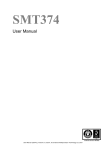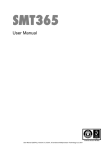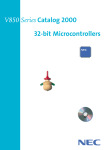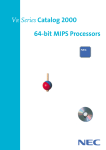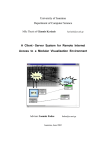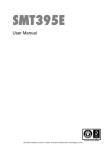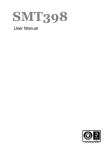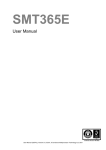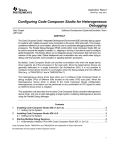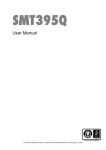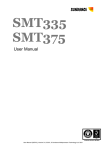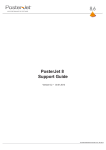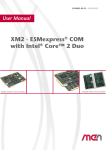Download User Manual - Sundance Multiprocessor Technology Ltd.
Transcript
SMT363XC2 User Manual User Manual (QCF42); Version 3.0, 8/11/00; © Sundance Multiprocessor Technology Ltd. 1999 Version 2.2 Page 2 of 27 SMT363XC2 User Manual Revision History Date Comments Engineer Version 14/11/03 First release JPA 1.0.0 02/12/03 Added addressing mode section (LED Setting) JPA 1.0.1 JPA 1.0.2 Updated ComPort section 20/10/04 Updated block diagram. Removed endianess section Updated LED section Replaced Timer and interrupt section by Interrupt section 07/06/05 Added: power consumption SM 1.0.3 09/08/05 Update: Support the firmware V1.1 SM 2.0 05/12/05 Updated LED descriptions. GP 2.1 29/11/07 Removed HPI connection from block diagram. GP 2.2 Version 2.2 Page 3 of 27 SMT363XC2 User Manual Table of Contents Revision History.......................................................................................................... 2 Table of Contents ....................................................................................................... 3 Contacting Sundance ................................................................................................. 5 Notational Conventions .............................................................................................. 6 DSP ........................................................................................................................ 6 SDB ........................................................................................................................ 6 SHB ........................................................................................................................ 6 Register Descriptions .............................................................................................. 6 Outline Description ..................................................................................................... 7 Intended Audience...................................................................................................... 7 Block Diagram ............................................................................................................ 8 Architecture Description ............................................................................................. 9 NET+50 ...................................................................................................................... 9 DSP ............................................................................................................................ 9 Boot Mode............................................................................................................... 9 DPRAM ................................................................................................................. 10 EMIF Control Registers......................................................................................... 10 CE1 - IO Control ................................................................................................... 11 SDRAM..................................................................................................................... 11 FLASH ...................................................................................................................... 11 RS232 ...................................................................................................................... 12 Serial ports ............................................................................................................... 12 FPGA........................................................................................................................ 12 Version control ...................................................................................................... 12 Firmware versions .................................................................................................... 12 Reprogramming the firmware and boot code............................................................ 12 Comports .................................................................................................................. 13 SHB .......................................................................................................................... 13 Architecture........................................................................................................... 13 Global bus ................................................................................................................ 13 Version 2.2 Page 4 of 27 SMT363XC2 User Manual LED Setting .............................................................................................................. 14 LED Register......................................................................................................... 14 CONFIG & NMI......................................................................................................... 15 Config Register ..................................................................................................... 15 Timer ........................................................................................................................ 16 Timer Control Register .......................................................................................... 16 IIOF interrupt ............................................................................................................ 17 Code Composer ....................................................................................................... 18 Application Development .......................................................................................... 18 SMT6400 .............................................................................................................. 18 SMT6060 .............................................................................................................. 18 3L Diamond........................................................................................................... 18 SMT6500 .............................................................................................................. 18 FPGA Memory Map.................................................................................................. 19 SHB pinout ............................................................................................................... 20 SHB generic pin-out .............................................................................................. 20 Jumper Pin-Outs....................................................................................................... 21 JP1 - NET+50 connections ............................................................................ 21 JP2 - Serial port header ................................................................................. 21 JP3 - Xilinx CPLD programming port. ............................................................ 22 JP4 - NetICE port........................................................................................... 22 LED Descriptions...................................................................................................... 23 Mechanical Configuration ......................................................................................... 24 Operating Conditions................................................................................................ 25 Safety.................................................................................................................... 25 EMC ...................................................................................................................... 25 General Requirements .......................................................................................... 25 Power Consumption.............................................................................................. 25 Bibliography.............................................................................................................. 26 INDEX ...................................................................................................................... 27 Version 2.2 Page 5 of 27 SMT363XC2 User Manual Contacting Sundance You can contact Sundance for additional information by login onto the Sundance support forum. Please note that first users have to register first. Version 2.2 Page 6 of 27 SMT363XC2 User Manual Notational Conventions DSP The terms DSP, C6713 and TMS320C6713 will be used interchangeably throughout this document. SDB The term SDB will be used throughout this document to refer to the Sundance Digital Bus interface. SHB The term SHB will be used throughout this document to refer to the Sundance Highspeed Bus interface. Register Descriptions The format of registers is described using diagrams of the following form: 31–24 23–16 15–8 7–0 R,00000000 R,10000000 OFLAGLEVEL R,00000000 RW,10000000 The digits at the top of the diagram indicate bit positions within the register and the central section names bits or bit fields. The bottom row describes what may be done to the field and its value after reset. Shaded fields are reserved and should only ever be written with zeroes. R Readable by the CPU W Writeable by the CPU RW Readable and writeable by the CPU Binary digits indicate the value of the field after reset Version 2.2 Page 7 of 27 SMT363XC2 User Manual Outline Description The SMT363XC2 is an Ethernet module, size 1 TIM offering the following features: NetSilicon ARM-chip Net+50 TMS320C6713 processor running at 225MHz Six Comports 64MB of SDRAM 8MB Flash ROM Global Bus connector High bandwidth data I/O via 2 Sundance Digital Buses (SDB) Intended Audience There are two existing versions of the firmware for the SMT363XC2. These two versions differ by the number and the type of communication resources (comport and SDB interfaces) provided. For each of the versions of the different firmware is loaded in the FPGA: - Firmware version 1.0 or - Firmware version 1.1 This user manual covers the version 1.1 of the firmware for the SMT363XC2 implemented with the model described in the SMT6500 help file. The changes between the firmware version 1.0 and version 1.1 are described in the section Firmware versions. Version 2.2 Page 8 of 27 SMT363XC2 User Manual Block Diagram The following drawing shows the block diagram of the SMT363XC2 module. The main components of the SMT363XC2 are: - A Texas Instruments DSP - One Xilinx Virtex-II FPGA - One NetSilicon ARM Net+50 device with integrated MAC controller for connection to an Ethernet network. - 16/64MB of SDRAM DSP and FPGA PSU J1 Top Primary TIM Connector Comm-Port 3 Timer,& Control 15 I/O pins 2x Comm-Ports/SDL 24 I/O pins 8M bytes Flash 4 LEDs & 4 I/O pins 16/64M bytes SDRAM 2 x (4/16M x 16) 32-bit EMIF 'C6211/6711/6713 DSP McBSP, GPIO, LEDs Xilinx FPGA Virtex-II JTAG Header 1.5V Dual Port RAM J3 Global Expansion Connector 4x Comm-Port/SDL 48 I/O pins Global Bus 74 I/O pins Sundance High-speed Bus 60-way Samtec J2 Bottom Primary TIM Connector Comm-Port 1, 2, 4 Figure 1: SMT363XC2 block diagram NET+50 16M bytes SDRAM 2 x (4M x 16) RJ45, RS232, LEDs Version 2.2 Page 9 of 27 SMT363XC2 User Manual Architecture Description NET+50 The NET+50 is a cost-effective, high-performance 32-bit network attached microprocessor developed especially for high-bandwidth applications in Intelligent Networked Devices. Based on ARM's architecture, it integrates 10/100Base-T Ethernet MAC with an MII interface, a distributed 10-channel linking DMA controller and a memory controller supporting all of the popular memory devices in use today. This device is connected directly to an Intel LXT971 PHY device, which provides an IEEE 802.3 compatible 10Base-T and 100Base-T physical layer interface. Also, directly connected to the NET+50 are 16Mbytes of SDRAM, an RS232 level converter and a 128KB Dual Port RAM (DPRAM). LEDs 4 and 4 are controlled via PORTA bits 0 and 1. DSP The Texas Instruments DSP can run at up to 225MHz. The DSP is doted of 16MB (optional 64MB) of SDRAM. The DSP is a TMS320C6713 type. An on-board 37.5MHz crystal oscillator provides the clock used for the DSP which then multiplies this by for input to the DSP. DSP internally multiplies this up to the required frequency, using a PLL. Boot Mode The DSP is connected to the on-board flash ROM that contains the Sundance bootloader and the FPGA bitstream. Following reset, the DSP will automatically load the data from the flash ROM into its internal program memory at address 0 and then start executing from there. All this code is the Sundance bootloader, and it is made up of three parts: FPGA configuration, processor configuration and the Comport boot procedure. FPGA configuration uses data in the ROM to configure the FPGA. A processor configuration sets the processor into a standard state, copies its comport boot procedure into a dual-port RAM (DPRAM) implemented in the FPGA, and releases the NET+50 chip from reset. The Net+50 chip is configured to boot from this DPRAM. The bootloader is executed. It will continually check the six comports until data appears on one of them. This will next load a program in boot format from this comport. Note that the bootloader will not read data arriving on other comports. Finally the control is passed to the loaded DSP application. It is safest to wait for the configuration to complete. Note that comports will appear to be "not ready" until the FPGA has been configured. The FPGA programming algorithm is not described here. It can be found in the boot code. Version 2.2 Page 10 of 27 SMT363XC2 User Manual DPRAM The DPRAM in the FPGA is only intended to be used during this boot process; more general use is not recommended. A 128KB memory is directly connected to both the DSP and the NET+50 devices. Each can access the memory independently and at their respective maximum data rates. The DPRAM is decoded as the boot ROM in the NET+50’s memory space. The DPRAM supports the generation of interrupts to either of its ports. This functionality is achieved by the DSP writing to a specific DPRAM address, which in turn generates an interrupt to the NET+50 (PINT2* pin). Similarly, the NET+50 can write to a specific address which generates an interrupt which can be routed to the DSP. EMIF Control Registers The DSP has a single external memory interface (EMIF) which is 32 bits wide. A full description of the registers used to control the EMIF can be found in the DSP C6000 Peripherals Reference GuideError! Reference source not found.Error! Reference source not found.. The standard bootstrap will initialise these registers to use the following resources: Memory space Resource Address range CE0 SDRAM 0x80000000 - 0x83FFFFFF CE1 Flash / IO Control 0x90000000 - 0x903FFFFF CE2 DPRAM 0xA0000000 - 0xA7FFFFFF CE3 Virtex 0xB0000000 - 0xB0FFFFFF (EMIF) The power on (and reset) state for the semaphore enable (DPRAM related) is disabled. This bit determines whether the flash or DPRAM-semaphore registers are accessed on CE1. Version 2.2 Page 11 of 27 SMT363XC2 User Manual CE1 - IO Control Several I/O connections are required to control the NET+50 reset signal, upper flash address signals, and the control signals for FPGA programming. These are all accessed via the CE1 memory space and defined settings for some data lines. D31 D30 D29 D0 Function 0 0 0 X Flash write 0 0 1 N NET+50 reset control. Reset(active low)=N 0 1 0 N Flash address A20 control. A20=N 0 1 1 N Flash address A21 control. A21=N 1 0 0 N FPGA PROG pin control. PROG(active low)=N 1 0 1 X FPGA CCLK pin control. Generates pulse on CCLK 1 1 0 N DPRAM semaphore enable when N=1 SDRAM Memory space CE0 is used to access 16MB (or optional 64MB) of SDRAM over the EMIF. The speed of the SDRAM is dependent on the processor variant. Using the C6713, the SDRAM will operate at 100MHz. Using the C6713, the SDRAM operates at a programmable rate up to the maximum allowed on the EMIF. The EMIF CE0 memory space control register should be programmed with the value 0x00000030. FLASH An 8MB Flash ROM is connected to the DSP in the EMIF CE1 memory space. The ROM holds boot code for the DSP, configuration data for the FPGA, the boot code for the Net+50 chip and optional user-defined code. A software protection algorithm is in place to prevent programs accidentally altering the ROM’s contents. Please contact Sundance for further information about reprogramming this device. The CE1 memory space control register should be programmed with the value 0xFFFFFF23. Version 2.2 Page 12 of 27 SMT363XC2 User Manual RS232 A single RS-232 channel is provided at true RS232 levels. The signals provided are TBD and are presented on wire-wrap posts. Serial ports The DSP provides two serial ports, which are connected to a pin header on the SMT363XC2 module. Additionally, some of the serial port signals are connected to the Virtex2 FPGA in order to provide extra signals, which can be used for external interrupts. FPGA The FPGA (Field Programmable Gate Array) is a Xilinx Virtex-II XC2V1000 device. It implements the following communication resources: • Six comport interfaces • Two 16-bit Sundance Digital Bus interfaces • One global bus interface Version control Revision numbers for both the boot code and FPGA firmware are stored in the Flash ROM during programming as zero-terminated ASCII strings. The SMT6001 utility can be used to display the version numbers of the bootloader and the FPGA data. Firmware versions The SMT6001 utility includes the latest version of the bootloader and the latest version of the FPGA data that implements the FPGA architecture described in the SMT6500 help file. Note that the new firmware supports two more comports. Customers who wish to use the old firmware that supported only 4 comports options can obtain it from our support web forum. Reprogramming the firmware and boot code The contents of the flash ROM are managed using the SMT6001 utility. This includes the latest firmware and bootloader along with complete documentation on how to reprogram the ROM. The utility assumes that you have Code Composer Studio installed and that it has been configured correctly for the installed TIMs. The Sundance Wizard can help you with this. To confirm that the ROM has been programmed correctly, you should run the confidence test in the BoardInfo utility (SMT6300). Version 2.2 Page 13 of 27 SMT363XC2 User Manual Comports The DSP has 6 comports, numbered 0 to 5. The addresses of the Comport registers are shown in the Error! Reference source not found., and are described in the SMT6400 help file. SHB The SMT363XC2 provides one SHB connector, which is connected to the DSP to give two 16-bit SDB interfaces. These interfaces operate with a fixed clock rate of 100MHz. Architecture SDB0 and SDB1 on the DSP are presented on the TIM's SHB connector, SDBA and SDBB respectively. SDBB SDBA The addresses of the SDB registers are shown in the Virtex Memory Map, and are described in the SMT6400 help file. Global bus The SMT363XC2 provides a single global bus interface. This is only accessible from the DSP. The addresses of the global bus registers are shown in the Virtex Memory Map, and are described in the SMT6400 help file. Version 2.2 Page 14 of 27 SMT363XC2 User Manual LED Setting The SMT363XC2 has 8 LEDs. LED D1 always displays the state of the FPGA DONE pin. This LED is off when the FPGA is configured (DONE=1) and on when it is not configured (DONE=0). This LED should go on when the board is first powered up and go off when the FPGA has been successfully programmed (this is the standard operation of the boot code resident in the flash memory device). If the LED does not light at power-on, check that you have the mounting pillars and screws fitted properly. If it stays on, the DSP is not booting correctly, or is set to boot in a non-standard way. Two of the LEDs (D2-3) can be controlled with the LED register. Writing 1 will illuminate the LED; writing 0 will turn it off. LED Register (0xB00D0000) 31–4 3 2 1 0 - - LED D3 LED D2 RW,0 RW,1 RW,0 RW,0 Despite LED register bit 2 is writable; user should not change the value of this bit. When SMT363XC2 embeds 16MB of SDRAM, the DSP is configured to access SDRAM with 8 column address bits and 12 row address bits, whereas when SMT363XC2 embeds 64MB SDRAM, it’s configured with 10 column address bits and 13 row address bits (EMIF SDRAM Control register). It results that FPGA’s is moved in the DSP’s memory space. Writing a value to this bit changes the way the FPGA decodes the address, and therefore it's location in the EMIF memory space. This bit should be set to ‘1’ when 64MB of SDRAM are fitted on-board; otherwise it should be set to ‘0’ when 16MB of SDRAM are fitted on-board. Version 2.2 Page 15 of 27 SMT363XC2 User Manual CONFIG & NMI The TIM specification describes the operation of an open-collector type signal CONFIG that is driven low after reset. This signal, on a standard C4x based TIM, is connected to the processor’s IIOF3 pin. On the SMT365, the CONFIG signal is asserted after power on, and can be released by writing the value (1<<6) to the config register. Conversely, CONFIG may be reasserted by writing 0 to this bit. It is not possible for software to read the state of the CONFIG signal. The NMI signal from the TIM connector can be routed to the DSP NMI pin. WARNING: Several software components include code sequences that assume setting GIE=0 in the DSP CSR will inhibit all interrupts; NMI violates that assumption. If an NMI occurs during such code sequences it may not be safe to return from the interrupt. This may be particularly significant if you are using the compiler’s software pipelining facility. Config Register 31–8 Field CONFIG NMI 7 6 NMI CONFIG Description 0 drive CONFIG low 1 tri-state CONFIG 0 Disconnect NMI from the DSP 1 Connect NMI from TIM to the DSP. Config and NMI DSP lines are described in the SMT6400 help file. 5–0 Version 2.2 Page 16 of 27 SMT363XC2 User Manual Timer The TIM TCLK0 and TCLK1 signals can be routed to the DSP’s TOUT/TINP pins. The signal direction must be specified, together with the routing information in the timer control register. Timer Control Register Field 31–6 5 4 3–0 Reserved TCLK1 TCLK0 Reserved Description TCLK0 TCLK1 0 TIM TCLK0 is an input 1 Enable TIM TCLK0 as an output 0 TIM TCLK1 is an input 1 Enable TIM TCLK1 as an output If the TIM TCLKx pin is selected as an output, the DSP TOUTx signal will be used to drive it. The TIM TCLKx pin will always drive the DSP TINPx input. TCLK0EN C6x TOUT0 TINP0 TCLK0 FPGA The Timer control register is described in the SMT6400 help file. Version 2.2 Page 17 of 27 SMT363XC2 User Manual IIOF interrupt The firmware can generate pulses on the external interrupt lines of the TIM. Only the interrupt line IIOF1 and IIOF2 are connected from/to the DSP and the HOST. • IIOF1 is connected from the DSP side to the HOST side: so, the DSP interrupts the HOST • IIOF2 is connected from the HOST side to the DSP side: so, the HOST interrupts the DSP The IIOF interrupt lines are described in the SMT6400 help file. Version 2.2 Page 18 of 27 SMT363XC2 User Manual Code Composer This module is fully compatible with the Code Composer Studio debug and development environment. This extends to both the software and JTAG debugging hardware. The driver to use is the tixds6x1x_11.dvr. CCS version 3.0 or later is required as the reprogramming utility (SMT6001) requires it. Troubleshooting Our Knowledge data base and FAQ sections may help you to resolve some known issues. Application Development Depending on the complexity of your application, you can develop code for SMT363XC2 modules in several ways. SMT6400 For simple applications, the Sundance SMT6400 software support package (project examples) and its associated header files (SmtTim.h and ModSup.h) can suffice. The SMT6400 product is installed by the Sundance Wizard and it is free of charge. SMT6060 SMT6060-FTP is a utility that allows and easy and cost-effective integration of the Net+50 ARM chip and the DSP that can be found on SMT363. It is ready to use and provide a TCI/IP interface to a host. SMT6060-TCPIP is a software package that provides Ethernet connectivity via the industry standard Berkeley sockets interface to a 3L/Diamond network of DSP processors. The package is typically used when there is at least one SMT363 present in the system; however, using a feature of the SMT6025 software package, it also provides seamless connectivity via the HOST PC’s (Winsock 2.2) Ethernet hardware. The software is ready-to-use and provides sockets connectivity to any Sundance DSP processor. 3L Diamond This module is fully supported by 3L Diamond, which Sundance recommends for all but the simplest of applications. An SMT363XC2 has to be declared as appropriate in configuration files as one processors of type: • SMT363XC2_1 (16MB SDRAM) • SMT363XC2_2 (64MB SDRAM) SMT6500 This is the support package for the FPGA. It may be used to develop your application in the FPGA of the module. Version 2.2 Page 19 of 27 SMT363XC2 User Manual FPGA Memory Map volatile unsigned *SMT363CP0 =(unsigned *)0xB0000000; volatile unsigned *SMT363CP1 =(unsigned *)0xB0008000; volatile unsigned *SMT363CP2 =(unsigned *)0xB0010000; volatile unsigned *SMT363CP3 =(unsigned *)0xB0018000; volatile unsigned *SMT363CP4 =(unsigned *)0xB0020000; volatile unsigned *SMT363CP5 =(unsigned *)0xB0028000; volatile unsigned *SMT363CP0_STAT =(unsigned *)0xB0004000; volatile unsigned *SMT363CP1_STAT =(unsigned *)0xB000C000; volatile unsigned *SMT363CP2_STAT =(unsigned *)0xB0014000; volatile unsigned *SMT363CP3_STAT =(unsigned *)0xB001C000; volatile unsigned *SMT363CP4_STAT =(unsigned *)0xB0024000; volatile unsigned *SMT363CP5_STAT =(unsigned *)0xB002C000; volatile unsigned *SMT363STAT =(unsigned *)0xB003C000; volatile unsigned *SMT363SDBA =(unsigned *)0xB0040000; volatile unsigned *SMT363SDBB =(unsigned *)0xB0050000; volatile unsigned *SMT363SDBA_STAT =(unsigned *)0xB0048000; volatile unsigned *SMT363SDBB_STAT =(unsigned *)0xB0058000; volatile unsigned *SMT363SDBA_FLAG =(unsigned *)0xB004C000; volatile unsigned *SMT363SDBB_FLAG =(unsigned *)0xB005C000; volatile unsigned *GLOBAL_BUS =(unsigned *)0xB00A0000; volatile unsigned *GLOBAL_BUS_CTRL =(unsigned *)0xB0080000; volatile unsigned *GLOBAL_BUS_START =(unsigned *)0xB0088000; volatile unsigned *GLOBAL_BUS_LENGTH =(unsigned *)0xB0090000; volatile unsigned *SMT363TCLK =(unsigned *)0xB00C0000; volatile unsigned *SMT363TIMCONFIG =(unsigned *)0xB00C8000; volatile unsigned *SMT363LED =(unsigned *)0xB00D0000; volatile unsigned *SMT363INTCTRL4 =(unsigned *)0xB00E0000; volatile unsigned *SMT363INTCTRL4_EXT =(unsigned *)0xB00E4000; volatile unsigned *SMT363INTCTRL5 =(unsigned *)0xB00E8000; volatile unsigned *SMT363INTCTRL4_EXT =(unsigned *)0xB00Ec000; volatile unsigned *SMT363INTCTRL6 =(unsigned *)0xB00F0000; volatile unsigned *SMT363INTCTRL4_EXT =(unsigned *)0xB00f4000; volatile unsigned *SMT363INTCTRL7 =(unsigned *)0xB00F8000; volatile unsigned *SMT363INTCTRL4_EXT =(unsigned *)0xB00fc000; Version 2.2 Page 20 of 27 SMT363XC2 User Manual SHB pinout SHB generic pin-out QSH Pin number CLK 1 2 D0 D1 3 4 D2 D3 5 6 D4 D5 7 8 D6 D7 9 10 D8 D9 11 12 D10 D11 13 14 D13 15 16 D14 D15 17 18 USERDEF0 USERDEF1 19 20 USERDEF2 USERDEF3 21 22 WEN REQ 23 24 ACK 25 26 27 28 29 30 31 32 33 34 35 36 CLK 37 38 D0 D1 39 40 D2 D3 41 42 D4 D5 43 44 D6 D7 45 46 D8 D9 47 48 D10 D11 49 50 D13 51 52 D14 D15 53 54 USERDEF0 USERDEF1 55 56 USERDEF2 USERDEF3 57 58 WEN REQ 59 60 ACK Note: Hw is a short for Half-word (i.e. 16-bit Word) Hw Hw0 QSH Pin number Hw1 Hw1 Hw0 Hw D12 D12 Version 2.2 Page 21 of 27 SMT363XC2 User Manual Jumper Pin-Outs JP1 JP2 - NET+50 connections - 1 11 SPI_CLK SPE_EN 2 12 SPI_RX SPI_TX 3 13 RXD TXD 4 14 RTS CTS 5 15 DTR DCD 6 16 DSR RI 7 17 V33 GND 8 18 FA6 FA78 9 19 FA3 FA45 10 20 FA1 FA2 Serial port header 2 4 6 8 10 12 14 16 FSX1 FSR1 DX1 DR1 CLKX1 CLKR1 CLKS1 GND FSX2 FSR2 DX2 DR2 CLKX2 CLKR2 CLKS2 GND 1 3 5 7 9 11 13 15 Refer to the DSP’s Peripheral Reference Guide for signal description and usage. Version 2.2 JP3 JP4 - - Page 22 of 27 SMT363XC2 User Manual Xilinx CPLD programming port. 1 2 V33 TCK 3 4 GND TMS 5 6 TDO TDI 1 2 TCLK TRST (NC) 3 4 TMS NC 5 6 TDI V33 7 8 TDO GND NetICE port Typically, TRST is not connected to the NET+50. Version 2.2 Page 23 of 27 SMT363XC2 User Manual LED Descriptions LED Connection Function 1 FPGA.DONE Shows the state of the FPGA’s configuration. If this LED is ON, then the FPGA is NOT configured. This LED should power up in the ON state and extinguish after a second. 2 FPGA.LED0 Controlled by the LED register. DSP Heartbeat (SMT6060-TCPIP, rpcproxy.tsk) 3 FPGA.LED1 Controlled by the LED register. 4 NET50.PORTA0 Controlled by PORTA bit 0 of the NET+50. Net+50 Heartbeat (SMT6060-TCPIP, netsocksvr_v0p5p7.dat) 5 NET50.PORTA1 Controlled by PORTA bit 1 of the NET+50. 6 PHY.LED3 Link receive status (ON=receiving, OFF=not receiving) 7 PHY.LED2/NET50.PORTC6 Link up status (ON=connected, OFF=disconnected) 8 PHY.LED1 Link speed status (ON=100Mbit, OFF=10Mbit) Version 2.2 Mechanical Configuration Page 24 of 27 SMT363XC2 User Manual Version 2.2 Page 25 of 27 SMT363XC2 User Manual Operating Conditions Safety The module presents no hazard to the user. EMC The module is designed to operate within an enclosed host system that provides adequate EMC shielding. Operation within the EU EMC guidelines is only guaranteed when the module is installed within an appropriate host system. The module is protected from damage by fast voltage transients introduced along output cables from outside the host system. Short-circuiting any output to ground does not cause the host PC system to lock up or reboot. General Requirements The module must be fixed to a TIM40-compliant carrier board. The SMT363XC2 TIM is in a range of modules that must be supplied with a 3.3V power source. In addition to the 5V supply specified in the TIM specification, these new generation modules require an additional 3.3V supply to be presented on the two diagonally-opposite TIM mounting holes. The lack of this 3.3V power supply should not damage the module, although it will obviously be inoperable; prolonged operation under these circumstances is not recommended. The SMT363XC2 is compatible with all Sundance TIM carrier boards. It is a 5V tolerant module, and as such, it may be used in mixed systems with older TIM modules, carrier boards and I/O modules. Use of the TIM on SMT327 (cPCI) motherboards may require a firmware upgrade. If LED D6 on the SMT363XC2 remains illuminated once the TIM is plugged in and powered up, the SMT327 needs the upgrade. The latest firmware is supplied with all new boards shipped. Please contact Sundance directly if you have an older board and need the upgrade. The external ambient temperature must remain between 0°C and 40°C, and the relative humidity must not exceed 95% (non-condensing). Power Consumption The power consumption of this TIM is dependent on the operating conditions in terms of core activity and I/O activity. The SMT363XC2 module consumes about 3.18 Watts. Bibliography 1. Sundance Help file 2. SMT6400 help file (DSP support package) and SMT6500 help file (FPGA support package) 3. SMT6060 user manual (Ethernet support package) 4. NET+50 Microprocessor 5. TMS320C6000 Peripherals Reference Guide (literature number SPRU190) It describes common peripherals available on the TMS320C6000 digital signal processors. This book includes information on the internal data and program memories, the external memory interface (EMIF), the host port, multichannel-buffered serial ports, direct memory access (DMA), clocking and phase-locked loop (PLL), and the power-down modes. 6. TIM-40 MODULE SPECIFICATION Including TMS320C44 Addendum 7. SDB Technical Specification 8. SHB Technical Specification 9. TMS320C4x User's Guide (literature number SPRU063) It describes the C4x 32-bit floating-point processor, developed for digital signal processing as well as parallel processing applications. Covered are its architecture, internal register structure, instruction set, pipeline, specifications, and operation of its six DMA channels and six communication ports. Software and hardware applications are included. 10. Xilinx Virtex-II datasheet 11. TMSC6713 datasheet User Manual (QCF42); Version 3.0, 8/11/00; © Sundance Multiprocessor Technology Ltd. 1999 Version 2.2 Page 27 of 27 SMT363XC2 User Manual INDEX A M Application Development · 18 memory space (CE0 to CE3) · 10 B N Bibliography · 26 Notational Conventions · 6 C O Code Composer · 18 CONFIG & NMI · 15 Contacting Sundance · 5 Operating Conditions · 25 E email address · 5 F Firmware versions · 12 I IIOF lines · 17 L LEDs · 14 FPGA DONE pin · 14 LED register · 14 P Power consumption · 25 R Register Descriptions · 6 S SDB · 13 SHB pinout · 20 SMT6400 · 18 SMT6500 · 18 T Timer · 16 V Version Control · 12



























